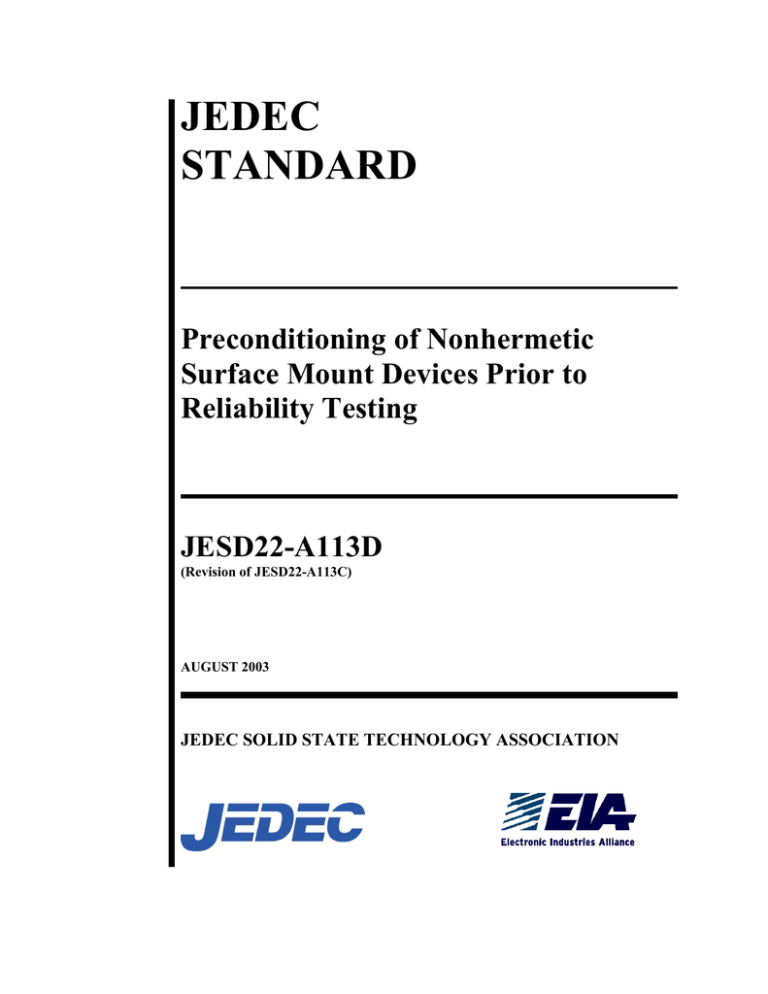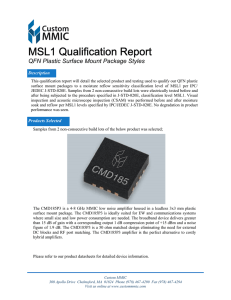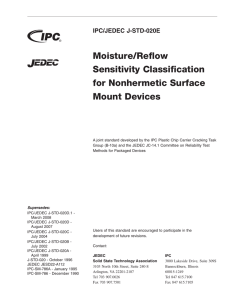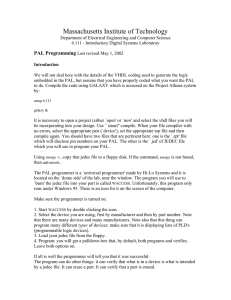
JEDEC
STANDARD
Preconditioning of Nonhermetic
Surface Mount Devices Prior to
Reliability Testing
JESD22-A113D
(Revision of JESD22-A113C)
AUGUST 2003
JEDEC SOLID STATE TECHNOLOGY ASSOCIATION
NOTICE
JEDEC standards and publications contain material that has been prepared, reviewed, and
approved through the JEDEC Board of Directors level and subsequently reviewed and approved
by the JEDEC legal counsel.
JEDEC standards and publications are designed to serve the public interest through eliminating
misunderstandings between manufacturers and purchasers, facilitating interchangeability and
improvement of products, and assisting the purchaser in selecting and obtaining with minimum
delay the proper product for use by those other than JEDEC members, whether the standard is to
be used either domestically or internationally.
JEDEC standards and publications are adopted without regard to whether or not their adoption
may involve patents or articles, materials, or processes. By such action JEDEC does not assume
any liability to any patent owner, nor does it assume any obligation whatever to parties adopting
the JEDEC standards or publications.
The information included in JEDEC standards and publications represents a sound approach to
product specification and application, principally from the solid state device manufacturer
viewpoint. Within the JEDEC organization there are procedures whereby a JEDEC standard or
publication may be further processed and ultimately become an ANSI/EIA standard.
No claims to be in conformance with this standard may be made unless all requirements stated in
the standard are met.
Inquiries, comments, and suggestions relative to the content of this JEDEC standard or
publication should be addressed to JEDEC at the address below, or call (703) 907-7559 or
www.jedec.org
Published by
©JEDEC Solid State Technology Association 2003
2500 Wilson Boulevard
Arlington, VA 22201-3834
This document may be downloaded free of charge; however JEDEC retains the
copyright on this material. By downloading this file the individual agrees not to
charge for or resell the resulting material.
PRICE: Please refer to the current
Catalog of JEDEC Engineering Standards and Publications online at
http://www.jedec.org/Catalog/catalog.cfm
Printed in the U.S.A.
All rights reserved
PLEASE!
DON’T VIOLATE
THE
LAW!
This document is copyrighted by JEDEC and may not be
reproduced without permission.
Organizations may obtain permission to reproduce a limited number of copies
through entering into a license agreement. For information, contact:
JEDEC Solid State Technology Association
2500 Wilson Boulevard
Arlington, Virginia 22201-3834
or call (703) 907-7559
JEDEC Standard 22-A113D
Page 1
TEST METHOD A113D
PRECONDITIONING OF NONHERMETIC SURFACE MOUNT DEVICES
PRIOR TO RELIABILITY TESTING
(From JEDEC Board Ballot JCB-02-120, and JCB-03-61, under the cognizance of the JC-14.1
Committee on Reliability Test Methods for Packaged Devices.)
1 Scope
This Test Method establishes an industry standard preconditioning flow for nonhermetic solid
state SMDs (surface mount devices) that is representative of a typical industry multiple solder
reflow operation. These SMDs should be subjected to the appropriate preconditioning sequence
of this document by the semiconductor manufacturer prior to being submitted to specific inhouse reliability testing (qualification and reliability monitoring) to evaluate long term reliability
(which might be impacted by solder reflow).
NOTE Correlation of moisture-induced stress sensitivity (per J-STD-020 and JESD22-A113) and actual
reflow conditions used are dependent upon identical temperature measurement by both the semiconductor
manufacturer and the board assembler. Therefore, it is recommended that the top of package temperature
on the hottest moisture-sensitive SMD during assembly be monitored to ensure that it does not exceed the
temperature at which the components are evaluated.
2 Apparatus
This test method requires as a minimum access to the following equipment.
2.1 Moisture chamber temperature
Moisture chamber(s) capable of operating at 85 °C/85% RH, 85 °C/60% RH, and 30 °C/60%
RH. Within the chamber working area, temperature tolerance must be ±2 °C and the RH
tolerance must be ±3% RH. A chamber with 60 °C/60% RH capability is optional for
accelerated soak conditions (See J-STD-020).
Test Method A113D
(Revision of Test Method A113-C)
JEDEC Standard 22-A113D
Page 2
2 Apparatus (cont’d)
2.2 Solder reflow equipment
a) (Preferred) - Full Convection reflow system capable of maintaining the reflow profiles
required by this standard.
b) Infrared (IR)/Convection solder reflow equipment capable of maintaining the reflow profiles
required by this standard. It is required that this equipment use IR to heat only the air and not
directly impinge upon the SMD Packages/devices under test.
NOTE The moisture sensitivity classification test results are dependent upon the package body
temperature (rather than the reflow carrier and or package terminal temperature).
2.3 Optical microscope
Optical Microscope (40x for external visual exam)
2.4 Electrical test equipment
Electrical test equipment capable of performing room temperature dc and functional tests.
2.5 Bake oven
Bake oven capable of operating at 125 +5/-0 °C.
2.6 Temperature Cycle Chamber
Temperature Cycle Chamber capable of operating as a minimum over the range of
(-40 +0/-10) °C to (60 °C +10/-0) °C per JESD22-A104. Acceptable alternative test conditions
and temperature tolerances are A through H, I, L, or M as defined in Table 1 of JESD22-A104,
Temperature Cycling. This equipment is only required if Step 3.1.3 Shippability option is used.
3 Test procedure
3.1 Steps
It is recommended that a prior evaluation be run according to J-STD-020, using similar devices,
to determine which preconditioning sequence is appropriate, i.e. likely to pass. Other relevant
moisture evaluation data may be consulted, or an arbitrary selection may be made. However, the
soak sequence in step 3.1.5 must be consistent with the floor life information in Table 1.
Test Method A113D
(Revision of Test Method A113-C)
JEDEC Standard 22-A113D
Page 3
3.1 Steps (cont’d)
3.1.1 Initial electrical test
Perform electrical dc and functional test to verify that the devices meet the room temperature
data sheet specification. Replace any devices that fail to meet this requirement.
3.1.2 Visual inspection
Perform an external visual examination under 40X optical magnification to ensure that no
devices with external cracks or other damage are used in this test method. If mechanical rejects
are found, corrective action must be implemented in the manufacturing process and a new
sample must be drawn from product that has been processed with the corrective action.
3.1.3 Temperature cycling
Perform five (5) cycles of temperature cycle from -40 °C (or lower) to 60 °C (or higher) to
simulate shipping conditions. This step is optional.
3.1.4 Bake out
Bake the devices for 24 hours minimum at 125 +5/-0 °C. This step is intended to remove all
moisture from the package so that it will be “dry.”
NOTE 1 This time/temperature may be modified if desorption data on the particular device being
preconditioned shows that a different condition is required to obtain a "dry" package. Refer to J-STD-020
for procedures on running absorption and desorption curves.
NOTE 2 If the preconditioning sequence is being performed by the semiconductor manufacturer, steps
3.1.1, 3.1.2, and 3.1.4 are optional since they are the supplier's risks. If the preconditioning sequence is
being performed by the user, steps 3.1.7 through 3.1.9 are optional.
Test Method A113D
(Revision of Test Method A113-C)
JEDEC Standard 22-A113D
Page 4
3.1 Steps (cont’d)
3.1.5 Soak conditions
The soak conditions in Table 1 shall apply to the eight (8) moisture sensitivity levels shown in
Table 3. Soak should be initiated within 2 hours of bake.
Table 1 — Required soak times in hours
Level
Soak requirements
Floor fife
Standard
Time
Conditions
1
Unlimited
≤30 °C/85% RH
2
1 year
≤30 °C/60% RH
2a
4 weeks
≤30 °C/60% RH
3
168 hours
≤30 °C/60% RH
4
72 hours
≤30 °C/60% RH
5
48 hours
≤30 °C/60% RH
5a
24 hours
≤30 °C/60% RH
Time
(hours)
168
+5/-0
168
+5/-0
6962
+5/-0
1922
+5/-0
962
+2/-0
722
+2/-0
482
+2/-0
6
Time on
Label (TOL)
≤30 °C/60% RH
TOL
Conditions
Accelerated equivalent 1
Time
Conditions
(hours)
85 °C/85% RH
85 °C/60% RH
30 °C/60% RH
30 °C/60% RH
30 °C/60% RH
30 °C/60% RH
30 °C/60% RH
120
+1/-0
40
+1/-0
20
+0.5/-0
15
+0.5/-0
10
+0.5/-0
60 °C/60% RH
60 °C/60% RH
60 °C/60% RH
60 °C/60% RH
60 °C/60% RH
30 °C/60% RH
NOTE 1 CAUTION - The “Accelerated Equivalent” soak requirements shall not be used until correlation of
damage response, including electrical, after soak and reflow is established with the “Standard” soak requirements
or the known activation energy for diffusion is 0.4 – 0.48 eV. Accelerated soak times may vary due to material
properties, i.e., Mold compound, encapsulant, etc. JESD22-A120 provides a method for determining the
diffusion coefficient.
NOTE 2 The Standard soak time includes a default value of 24 hours for semiconductor Manufacturer's
Exposure Time (MET) between bake and bag and includes the maximum time allowed out of the bag at the
distributor's facility.
If the actual MET is less than 24 hours the soak time may be reduced. For soak conditions of 30 °C/60% RH the
soak time is reduced by 1 hour for each hour the MET is less than 24 hours. For soak conditions of 60 °C/60%
RH, the soak time is reduced by 1 hour for each 5 hours the MET is less than 24 hours.
If the actual MET is greater than 24 hours the soak time must be increased. If soak conditions are 30 °C/60%
RH, the soak time is increased 1 hour for each hour that the actual MET exceeds 24 hours. If soak conditions are
60 °C/60% RH, the soak time is increased 1 hour for each 5 hours that the actual MET exceeds 24 hours.
NOTE 3 Supplier may extend the soak times at their own risk.
Test Method A113D
(Revision of Test Method A113-C)
JEDEC Standard 22-A113D
Page 5
3.1 Steps (cont’d)
3.1.6 Reflow
Not sooner than 15 minutes and not longer than 4 hours after removal from the
temperature/humidity chamber, subject the sample to 3 cycles of the appropriate reflow
conditions as defined in Table 2. If the timing between removal from the temperature/humidity
chamber and initial reflow cannot be met then the parts must be rebaked and resoaked according
to 3.1.4 and 3.1.5. The minimum time between reflows shall be 5 minutes.
Table 2 — Reflow profiles
Sn-Pb eutectic assembly
Reflow condition
Average ramp-up rate
(Liquidus Temperature (TL) to
Peak)
Preheat
- Temperature Min (Ts(min))
-
Temperature Max (Ts(max))
-
Time (min to max) (ts)
Pkg.
thickness
≥ 2.5 mm or
Pkg. volume
≥ 350 mm3
Pkg.
thickness
< 2.5 mm and
Pkg. volume
< 350 mm3
Pkg.
thickness
≥ 2.5 mm or
Pkg. volume
≥ 350 mm3
Pkg.
thickness
< 2.5 mm and
Pkg. volume
< 350 mm3
3 °C/second max.
3 °C/second max.
100 °C
150 °C
60-120 seconds
150 °C
200 °C
60-180 seconds
Ts(max) to TL
- Ramp-up Rate
Time maintained above:
- Temperature (TL)
- Time (tL)
Pb-Free assembly
3 °C/second max.
183 °C
60-150 seconds
217 °C
60-150 seconds
Peak Temperature (Tp)
225 +0/-5 °C
240 +0/-5 °C
245 +0/-5 °C
250 +0/-5 °C
Time within 5 °C of actual Peak
Temperature (tp)
10-30 seconds
10-30 seconds
10-30 seconds
20-40 seconds
Ramp-down Rate
Time 25 °C to Peak Temperature
NOTE
6 °C/second max.
6 °C/second max.
6 minutes max.
8 minutes max.
All temperatures refer to topside of the package, measured on the package body surface.
Test Method A113D
(Revision of Test Method A113-C)
JEDEC Standard 22-A113D
Page 6
3.1 Steps (cont’d)
3.1.6 Reflow (cont’d)
Figure 1 — Reflow profile
3.1.6.1 Solder attachment after reflow
If testing is to be performed in a second level configuration after final reflow the device, at the
user discretion, can be baked and vacuum sealed until such time that it is solder attached to the
test board or facsimile. Since the board attachment replicates a real life process of flux
application, reflow and cleaning, 3.1.7 and 3.1.8 are no longer necessary or mandated prior to
submission to reliability stress testing.
3.1.7 Flux application
After the reflow solder cycles are completed, allow the devices to cool at room ambient for 15
minutes minimum. Apply an activated water soluble flux to the device leads by bulk immersion
of the entire parts in flux at room ambient for 10 seconds minimum.
3.1.8 Cleaning
Clean devices externally using multiple agitated deionized water rinses. No waiting time is
required between flux application and cleaning.
3.1.9 Drying
Devices should be dried at room ambient prior to submission to reliability testing.
Test Method A113D
(Revision of Test Method A113-C)
JEDEC Standard 22-A113D
Page 7
3.1 Steps (cont’d)
3.1.10 Final electrical test
Submit the devices to electrical dc and functional testing per the room temperature data sheet
specification. (For the semiconductor manufacturer, this step is optional and may be omitted
since it is a supplier's risk.) Any valid failures found at this point due to the preconditioning
sequence indicate that the device may have been classified in the wrong level. Failure analysis
should be conducted. If appropriate, this device type should be reevaluated to determine the
correct moisture sensitivity level. This would require resubmitting a sample to the correct level
preconditioning sequence prior to reliability testing per 4.
4 Applicable reliability tests
SMDs should be subjected to the appropriate preconditioning sequence of this document prior to
being submitted to reliability tests per JESD47 or the semiconductor manufacturer’s in-house
reliability procedures.
5 Summary
The following details shall be specified in the applicable procurement document.
a) Number of reflow cycles if other than three.
b) Type flux if other than Step 3.1.7.
c) Reliability tests if other than 4.
d) Test conditions and duration of reliability tests in 4.
e) Electrical test description, including test temperature(s).
Test Method A113D
(Revision of Test Method A113-C)
JEDEC Standard 22-A113D
Page 8
5 Summary (cont’d)
Table 3 — Preconditioning sequence flow
Moisture sensitivity level
1
2
2a, 3, 4 5, & 5a
6
No
Yes
Yes
No
≤30 °C/85% RH
unlimited
≤30 °C/60% RH
1 year
≤30 °C/60% RH
“Y” hours
≤30 °C/60% RH
6 hours
after bake
Preconditioning Sequence
(Step 3.1.1) dc
electrical/functional 25 °C
R
R
R
R
(Step 3.1.2) 40x Visual Exam.
R
R
R
R
(Step 3.1.3) Shippability Temp
Cycle 5 cy -40 °C to 60 °C
O
O
O
O
(Step 3.1.4) Bake 125 °C for
24 Hours
R
R
R
R
(Step 3.1.5) Moisture Soak
168 hours 85 °C/85% RH
R
Dry Pack Requirements
Floor Life Maximum
Conditions & Time
168 hours 85 °C/60% RH
R
“z” hours 30 °C/60% RH
R
6 hours 30 °C/60% RH
R
(Step 3.1.6) Reflow Solder
Temperature per Table 2, 3
cycles
R
R
R
R
(Step 3.1.7) Flux immersion
for 10 seconds minimum
R
R
R
R
(Step 3.1.8) Rinse in deionized
water
R
R
R
R
(Step 3.1.9) Dry room ambient
R
R
R
R
(Step 3.1.10) dc
electrical/functional 25 °C
R
R
R
R
(4) Reliability tests
R
R
R
R
(4) dc electrical/function
25 °C end points
R
R
R
R
R = required unless text indicates optional step.
O = optional.
NOTE
For possible 60 °C/60% RH accelerated soak conditions, see J-STD-020.
Test Method A113D
(Revision of Test Method A113-C)
JEDEC Standard 22-A113D
Page 9
Annex A (informative) Differences between JESD22-A113D and JESD22-A113-C
The following list briefly describes most of the changes made to entries that appear in this
standard, JESD22-A113D, compared to its predecessor, JESD22-A113-C (February 2003). If
the change to a concept involves any words added or deleted, it is included. Punctuation changes
may not be included.
Page
Description of change
6
Add subclause 3.1.6.1, Solder attachment after reflow
Test Method A113D
(Revision of Test Method A113-C)
JEDEC Standard 22-A113D
Page 10
Test Method A113D
(Revision of Test Method A113-C)
Standard Improvement Form
JEDEC
JESD22-A113D
The purpose of this form is to provide the Technical Committees of JEDEC with input from the
industry regarding usage of the subject standard. Individuals or companies are invited to submit
comments to JEDEC. All comments will be collected and dispersed to the appropriate
committee(s).
If you can provide input, please complete this form and return to:
JEDEC
Attn: Publications Department
2500 Wilson Blvd. Suite 220
Arlington, VA 22201-3834
Fax: 703.907.7583
1. I recommend changes to the following:
Requirement, clause number
Test method number
Clause number
The referenced clause number has proven to be:
Unclear
Too Rigid
In Error
Other
2. Recommendations for correction:
3. Other suggestions for document improvement:
Submitted by
Name:
Company:
Address:
City/State/Zip:
Phone:
E-mail:
Date:




